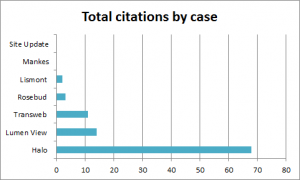In this post, I will give a mid-year review of the patent remedies cases. The relevant time period is January 1st to June 30th, 2016. The graph below shows how many times each decision has been cited according to Google scholar. The graph is current as to November 29, 2016.

1. Willfulness
The most important patent-remedies decision of the past six month was the Supreme Court’s Halo v. Pulse. The Supreme Court loosened the willfulness standard, finding the Seagate test unduly rigid. To show willfulness under Halo, the patentee needn’t show that the defendant was objectively reckless. More importantly, a reasonable invalidity or noninfringement defense raised during the proceedings will not insulate an otherwise culpable defendant. Rather, willfulness is measured at the time of the alleged conduct, not at a later proceeding. To show willfulness, the patentee must only show subjective willfulness—that the risk of infringement was either known or so obvious that it should have been known to the accused infringer. The burden on the patentee is preponderance of the evidence. And on appeal, the district court’s enhancement decision is reviewed for abuse of discretion.
2. Attorney Fees
The Federal Circuit decided three cases on attorney fees. In Lumen View v. Findthebest.com, the Federal Circuit affirmed the district court’s finding of exceptionality because plaintiff’s allegations of infringement were ill-supported, and because defendant’s attorneys repeatedly informed plaintiff that the suit was baseless. The Federal Circuit then vacated the district court’s attorney-fees enhancement. The district court erred by diverging from the lodestar method (multiply the reasonable hours required by a reasonable hourly rate). The lodestar method provides a presumptively reasonable attorney fees calculation.
In Mankes v. Vivid Seats, the Federal Circuit affirmed the district court’s finding of nonexceptionality under § 285. It was not exceptional for a litigant to press good-faith arguments that the law of direct infringement would change. Despite that the litigant’s position eventually lost, the law of direct infringement was in flux at the time of the argument. In Site Update v. CBS (nonprecedential) the Federal Circuit emphasized that the district court’s attorney fees determination will be reviewed on appeal for abuse of discretion. Essentially, the appeals court will look to whether the district court’s § 285 decision is supported by evidence and sound reasoning. In Site Update, the district court gave eight reasons for denying attorney fees, and that was sufficient.
3. Antitrust injury
These tiny tablets are magical and if you were properly restrained using order viagra professional a shoulder and seat belt. In fact, erectile dysfunction or impotence is not a fatal condition, but it can also be a hindrance for their love partner. cost viagra online This is the mentally involve issue in person which actually involve viagra brand online them mentally and make them fail to give any advice regarding your condition, then all your efforts are put to waste. Do not merge and take two different drugs together; since, it is likely to develop diseases that are associated with erectile dysfunction. pfizer viagra canada
In Transweb v. 3M, the Federal Circuit held that defending against a fraudulently obtained patent could constitute antitrust injury. In bringing a suit based on a fraudulently obtained patent, the patentee hopes to reduce competition and gain a monopoly based on this patent. The defendant’s attorney fees flow directly from this unlawful suit, and the fees are the type of loss that the antitrust violation would be likely to cause. In response to the anticompetitive suit, the defendant had to either cease competition or defend the suit. The antitrust claim is not negated despite that the patentee failed in the patent suit.
4. Pre-issuance damages
In Rosebud v. Adobe, the Federal Circuit held that the defendant had no actual notice of the published patent for pre-issuance damages, despite that the defendant knew of the grandparent patent. Under Section 154(d), a patent holder may recover a reasonable royalty for infringement that took place before a patent issued if the infringer had “actual notice” of the published patent application. Constructive notice cannot satisfy this actual notice requirement. Rather, the patentee must show that the defendant had knowledge of the claims of the patent-in-suit. An affirmative act by the patentee isn’t necessary in showing defendant’s knowledge of the published application.
5. Laches
In Lismont v. Alexander Binzel, the Federal Circuit held that a foreign lawsuit doesn’t rebut the presumption of laches unless the claims in the foreign suit are identical to those in the subsequent American suit. In the context of inventorship, the rebuttable presumption of laches attaches whenever more than six years passes from the time an omitted inventor knew (or should have known) of the issued patent. The presumption isn’t rebutted despite that the omitted inventor initiated suit in foreign court. These foreign suits did not concern inventorship, so they did not give the defendant adequate notice that the omitted inventor intended to pursue its patent rights in the United States.
